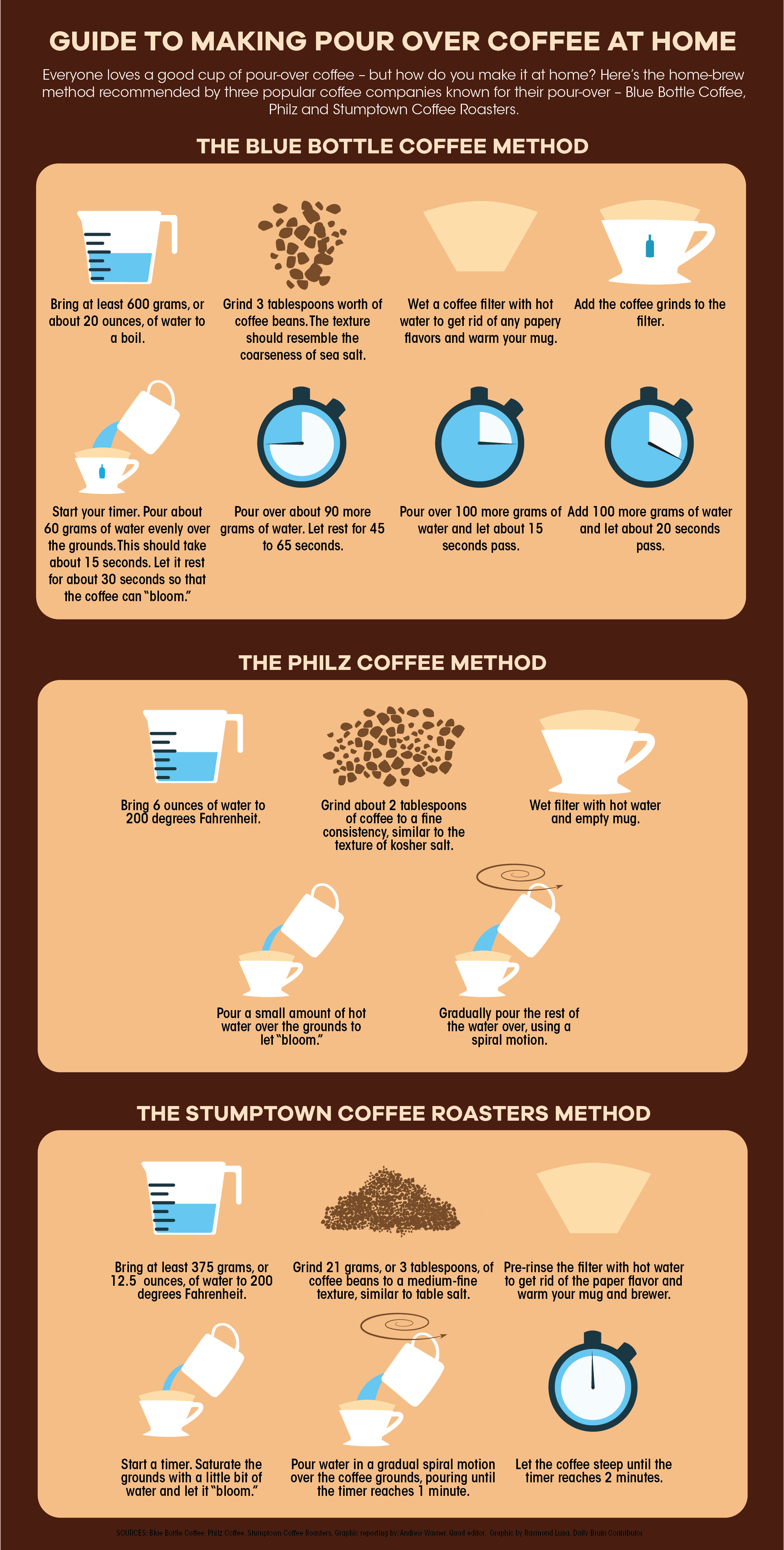The Quad: This finals week, learn the skillful science and adroit art behind pour over coffee

(Raymond Luna/Daily Bruin)

By Veronica Fernandez De Soto
Dec. 6, 2018 9:45 p.m.
Making pour over coffee is nothing short of a scientific spectacle.
Pour over coffee is a deceptively simple method of making freshly brewed coffee by grinding coffee, inserting it into a brewing system and then systematically pouring water over the grounds. Crafting the perfect cup involves patience and technique, but it also an understanding of basic principles of physics and chemistry such as osmosis, gas release, solubility and more.
Here, the Quad attempts to break down all of the elements that go into making that nice, smooth cup of pour over. With final exams looming, making pour over coffee might be the perfect meditative study break to keep you going.
Making pour over
Pour over coffee appeals to both coffee makers and lovers mostly because they can control the flavor of the brew. According to the coffee brewing blog Home Grounds, makers can control the taste, strength and consistency of the coffee using this method. Pour over techniques completely forsake the idea of coffee as a convenience, something done with a push of a button – instead, it becomes an artistic statement.
The method for pour over coffee is actually incredibly simple. It uses only water, ground coffee and relatively low-tech equipment such as a kettle, a dripper, filter paper and a digital scale for accurate results.
To simplify the process, Serious Eats recommends a quick and easy, three-step technique: wetting, dissolution and diffusion.
The first release of carbon dioxide slowly begins in the roasting process, and the following combination of water and ground coffee releases more carbon dioxide into the air immediately after one begins the first pouring – the “bloom.”
The entrapped carbon dioxide is an important part of the flavor of the coffee. According to Smithsonian Magazine, the less carbon dioxide present in the grounds, the less flavorful the grounds will be. This is why many cafes emphasize the use of freshly roasted coffee, as carbon dioxide and other gasses have not had as much time to escape the bean.
Blue Bottle Coffee, a third-wave coffee shop known for their pour over, recommends pouring hot water on the coffee slowly over the course of four pours. This method, known as wetting, is used because as water interacts with grounded coffee, carbon dioxide and more volatile compounds seek to escape the bean. Therefore, if carbon dioxide is exiting the coffee, no water will be able to go in. This is why coffee experts recommend waiting until the gas is released, which normally takes around 30-45 seconds after wetting.
Dissolution is the next step in this scientific process. The hot water dissolves the solubles in the bean’s cells – the more time the water has to dissolve and extract the bean’s solubles, the more undesirable flavors will develop. Quickness is key.
Digital scales determine the amount in each pour. To guarantee that only desirable solubles dissolve into the cup of coffee, a specific amount of water must be poured. For the first pour, Blue Bottle Coffee recommends only pouring 60 grams of water, then 90 grams for the second, and finally 100 grams in each of the last two pours.
Finally, in the diffusion step, the ground coffee left in the filter still has dissolved solubles, which will now need to move into the cup of coffee. This is best explained through the scientific process of osmosis. Osmosis is the movement of water through partially permeable cell membranes. Since the concentration of the brew is higher inside the cells of the coffee, the osmosis pressure equalizes the concentration by moving the brew to the other side of the membrane with less concentration. This guarantees that the brew will drip consistently, and signals the end of this methodical parade.
Controlling the taste
Pour over is generally a coffee-making method that involves tuning as well as trial and error. The coffee maker can usually look to two variables that will drastically change taste and texture: time that the grounds remain in water and ground size.
Home Grounds details the ways ground size changes taste. A larger granule will cause the water to flow over the coffee at a faster rate, while a smaller one will produce the opposite effect as the finer particles will prevent the water from easily flowing. Thus, with greater granules, your pour over will taste more sour and acidic, while smaller granules will brew a more bitter cup.
Timing the pour is equally important. According to Serious Eats, only about a third of the coffee beans are actually soluble, and most of the chemicals of the bean – which are generally organic acids and sugars – are healthy and tasty. However, there are also some bad-tasting chemicals that tend to be harder to dissolve and therefore take a longer time to be incorporated into the beverage. This means that if one leaves the grounds in the water for too much time, these chemicals will begin to dissolve and damage the brew.
Where to get it if you can’t make your own
There’s a certain magical element of watching pour over coffee being brewed. The dichotomy of simplicity and complexity makes this brewing method one that resonates with third-wave coffee shops.
The two most prominent and well-known pour over coffee places are Blue Bottle Coffee, which has its closest location to campus at the Westfield Century City mall, and Intelligentsia Coffee, which is located near Venice Beach. Chains like Peet’s Coffee or Starbucks in Westwood have also begun to offer pour over coffee as its popularity has risen among coffee aficionados.
Drinking pour over coffee feels different from just a plain old cup of coffee from Kerckhoff Coffee House, especially after exploring the extensive process behind a cup of fresh brew. It creates the notion that one is not simply drinking caffeine to stay awake, but instead submerging into an experience as scientifically unique as an art form. It will take more time than your regular morning cup, but as the barista pours the water through the dripper in a calculated circular motion, you won’t be able to take your eyes off it.


